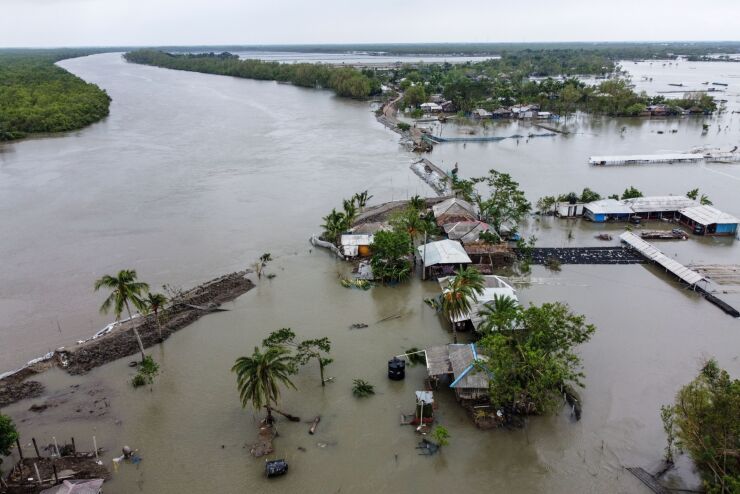Extreme weather exposures have shifted in recent years, causing natural disasters like flooding, hurricanes and wildfires in previously unaffected regions. These events can result in weeks or even months of repairing property damage and business interruption. In 2022, the U.S. experienced 18 weather and climate disasters,
Advanced technologies offer a forward-looking perspective akin to gazing through a windshield clouded because of a defect in the glass. With a cloudy view, risk managers defer to their rearview mirror and rely upon an analysis of the past to predict the future. However, as the climate and events become more unpredictable and costly, looking forward, no matter how foggy the view, for real-time model assessment and proactive measures may need to become the norm.
Acknowledging current weather-related model limitations
As a result of not being able to clearly see the road ahead, most major weather events have historically resulted in damage that was under-predicted by widely used weather modeling techniques. This under-prediction can be attributed to various factors, including the limited accuracy of the models and the underestimation of inflation and claim payouts. Consequently, the pricing of premiums is not solely driven by risk, but rather by the increased expectation of loss and additional liabilities discovered after the event.
Similar challenges are being faced in the
Why risk managers are slow to adapt to new technologies
Risk managers typically exercise caution when adopting new technologies, preferring to make decisions based on clear and compelling evidence. Emerging technologies offer the potential to provide quick and reliable empirical data, as exemplified by the widespread adoption of real-time monitoring systems in the auto and transportation industries to reduce accidents and minimize costs.
However, to achieve broad adoption of new technologies, it is essential to identify and monitor specific risks accurately and to provide a clear ROI (return on investment) or estimated ROI that justifies the expense. For these unknown and unexpected outcomes, firms may prefer to rely solely on insurance to manage the risk, as it may be a more cost-effective solution in the short term. Nevertheless, this approach can lead to future problems if premiums are inappropriately priced, highlighting the importance of comprehensive risk management strategies that consider a variety of approaches and adaptability to newer technologies that can help price premiums accordingly.
Relevant parties need to prioritize the acquisition of high-quality data. To achieve this, the data must undergo multiple scans or analyses that enhance its accuracy for decision-making purposes. The efficacy of models is highly dependent on the quality of data; thus, low-quality data will yield poor output, regardless of the model used.
Using quality data to uncover vulnerabilities
The first challenge lies in finding high-quality
The second issue concerns the efficient extraction of available data. In some instances, state governments have not invested in updated technology for their property tax systems, making it challenging to retrieve data and determine the actual geographical zone values required for the models to calculate insurance pricing. Investing in technology is necessary to enable informed decision-making with the available data. Therefore, it is essential to allocate resources now to ensure future savings.
Using quality data enables users to determine their loss sensitivity and potential aggregate loss. It also facilitates the determination of the hurdle rate – the minimum rate of return that the user requires from a project or investment to determine its viability, involving determining the appropriate compensation for the level of risk involved. The hurdle rate can be used to evaluate the feasibility of technology investments and secure management approval for such investments. Additionally, analyzing the potential reductions in exposure and cost of insurance is made possible.
More importantly, these technologies allow clients the ability to quickly identify the premiums they are paying, any losses or expenses, the adequacy of their coverage and how this is correlated to the hurdle rate - thereby providing risk managers with the information needed to make informed risk transfer decisions.
Advancements
The current weather tracking software that utilizes NOAA (National Oceanic and Atmospheric Administration) data is widely available. However, they may not always provide the resolution required to determine the impact of various loss scenarios. Recent technological advancements give the capacity to go beyond NOAA data and offer more comprehensive contexts related to geo codes and precise latitude/longitude coordinates that go well beyond ZIP Code-tied information, thus offering the highest resolution for potential loss probabilities.
New technologies have the capability to provide an analysis of potential exposures. For example, if a warehouse is in a region prone to extreme weather conditions, the tech can be used to assess the risk of potential damage and enable businesses to gain greater insight into the potential risks associated with climate-related events.
Risk managers utilizing advancements in predictive weather tech now have the capability to observe their environment straight ahead through a clearer windshield instead of making decisions based on what they see in a cloudy windshield or the rearview mirror. Additionally, they can utilize the data-based analysis of the local and its vulnerability to weather-related exposures to evaluate the pros and cons of making business-related decisions in the area, safely mitigating any potential risk before it's too late.






